Old world mice
| Old world mice | ||||||||||||
|---|---|---|---|---|---|---|---|---|---|---|---|---|

Wood mouse ( Apodemus sylvaticus ) |
||||||||||||
| Systematics | ||||||||||||
|
||||||||||||
| Scientific name | ||||||||||||
| Murinae | ||||||||||||
| Illiger , 1811 |
The old world mice (Murinae) are a subfamily of the long-tailed mice (Muridae). This group includes around 600 species, the best-known genera are the mice ( Mus ) and the rats ( Rattus ).
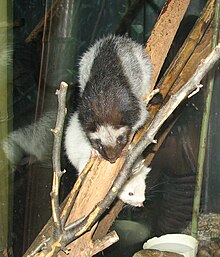
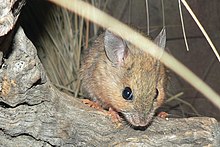


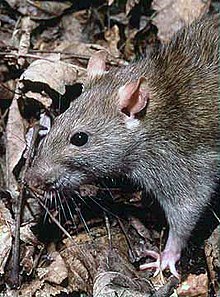
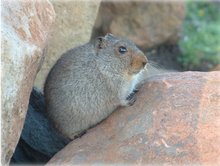
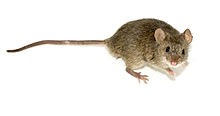
Body features
General physique
Old world mice are small and graceful to large, robust and heavy mice. Their head-to-trunk length is 55 or 60 millimeters ( harvest mouse and dwarf tree mice ) to 40 centimeters or more ( giant tree rats ). Large forms are relatively common, and several forms are known as giant rats (giant tree rats , white-eared giant rats , coryphomys , Flores giant rats, and giant bark rats ).
The variety in physique is just as great as that of the New World mice . According to Carleton and Musser (1984), the body structure of Old World mice reflects specializations similar to those of water shrews and otter shrews ( swimming rats and Monckton swimming rats ), small bottom-living shrews ( New Guinea moss mice , Shaw-Mayer mice and Microhydromys ), large bottom-living shrews ( small and Large Sulawesi shrew rat ), elephant-shrews ( Sulawesi echimyidae and nose rats ), kangaroo rat ( hopping mouse ), gerbils ( Komodo rat ), voles ( broad-toothed mouse , arvicanthis and otomys ), pocket gophers ( nesokia ), croissants ( crateromys ) Bilchen ( brush-tailed tree mice and surgeons ) as well as dwarf pouch rats ( monkey foot rats ).
The auricles of Old World mice are usually noticeable. Their tail is shorter than, as long as, or longer than the length of the head and torso. In monkey foot rats, the rear third of the tail above (dorsally) is designed as a grasping tail that can carry the body weight. In harvest mice , pogonomelomys , prey- tail rats and surgeons , only the tip of the tail is dorsally designed as a prehensile tail and is unable to carry the body weight. The tail scales of most forms are arranged in overlapping rows, but in some forms they do not overlap but rather form tessellated patterns (for example, tessellated rats ).
limbs
The forefoot of the old world mice has a stubby thumb with a nail and four other toes with claws . In some forms, the fifth toe is reduced to a stub so that the forefoot appears to have only three toes (for example furrow-tooth brook rats ).
The rear foot mostly reflects the adaptation to an ongoing lifestyle. In some forms, he is short and broad (for example Gray Tree Rat ), with many other long and narrow (for example, African long-eared mouse and African wading rat ), with few large and webbed provided (hydromys and Earless Water Rat). It has five toes, of which the first and fifth are greatly reduced and the middle three are elongated in some soil-dwelling forms ( Asian soft rats and furrow-tooth brook rats). Usually all toes of the hind foot have claws. Exceptions are the long-tailed climbing mice (with flat nails on the first and fifth toes), the brush-tailed tree mice, the Asian climbing rats and the Fea tree rat (with a flat nail on the first toe), the Sody tree rat (with a convex nail with a blunt edge on the first toe), the Luzon wide-tooth rat (with a pointed nail on the first toe) and the monkey foot rat (with a nail-like claw on the first toe). In some arboreal forms, the first and fifth toes are semi- opposable (brush-tailed tree mice, long-tailed climbing mice and Asian climbing rats).
The soles of the front and rear feet are bare. The hind feet usually have six soles , which in some forms are small and reduced in number ( Rajah rats and Asiatic soft rats ), whereas in arboreal forms they can be large and deeply grooved (e.g. brush-tailed tree mice and Margareta rats ) .
Fur and color
The fur of the Old World mice is silky, dense and woolly, velvety, coarse and thin on the head and trunk, mixed with spiky hair or dense and spiky (Sulawesi spiny rats, Ryukyu spiny rats and a type of Margareta rats). On top it is brown, yellow-brown or grayish to blackish. Some forms have a distinctive eel line ( striped mice and some types of furrow-toothed brook rats, wood mice and striped grass mice ) or several lines with different colors ( Luzon striped rats , African striped grass mice and most species of striped grass mice ). Apart from that, a pattern on the top is rare. The red-nosed rats have a rust-red nose and a rust-red rump and some forms of the Old World mice have ocher-colored flank lines. Tufts in front of or behind the eyes are rare. They occur in young animals and nestlings (Sody tree rats), but not in adults. The fur below is white, yellow-brown or grayish. It usually contrasts strikingly with the fur on the top, but it can also be the same color as the top.
The auricles of the old world mice are thin to thickly hairy. The tail appears bare in most forms, but in some it is densely hairy ( e.g. Luzon tree rats, gray tree rats and Margareta rats), bushy like croissants (a type of bark climber) or moderately hairy with a tassel (tree forms like e.g. brush-tail tree mice). It is usually monochrome, but can also be faint or noticeably two-colored (for example white-bellied rats and Rajah rats). The front third or the front half can be dark and the rest white (gray tree rat and many other Indo-Australian forms) or the tail is monochrome except for a white tip (for example prey-tail rats).
denture
As in all rodents, the two incisors of the old world mice are transformed into incisor teeth , behind which there is a gap called a diastema . Canines and premolars are always absent, and they have no more than three molars per half of the jaw, but sometimes only one or two.
distribution and habitat
The natural range of the old world mice includes Eurasia , Africa and Australia . This makes them the only land-bound higher mammals that were native to Australia and New Guinea before human colonization. They even settled these countries in two radiations, on the one hand the rats and on the other hand the hydromyini . The greatest biodiversity can be found in the tropical regions of Africa, Southeast Asia and New Guinea.
There are naturally no Old World mice on the American double continent - they are represented there by the New World mice . Three species, the house mouse , the house rat and the brown rat have meanwhile achieved worldwide distribution in the wake of humans. Some other species following culture have also been able to expand their habitat.
Old world mice inhabit a wide variety of habitats, they can be found in forests as well as in savannas and grasslands, in mountainous regions and in dry areas.
Way of life
There is also great diversity in terms of lifestyle. In addition to soil dwellers, there are also tree-dwelling species, as well as diurnal and nocturnal species and, in addition to solitary species, species that live in large groups.
Diet also varies, but many species are predominantly herbivores that feed on grasses, seeds, tubers, and other vegetable matter. Some species also or almost exclusively eat insects and other small animals or even small vertebrates.
The reproduction of old world mice is generally characterized by high fertility, a short gestation period and a low life expectancy.
Systematics
The old world mice comprise almost 600 species in around 130 genera. Due to the large number of taxa, the internal system is still largely unclear.
| Tribus according to Lecompte et al. (2008) | Generic groups according to Carleton & Musser (2005) | Genera |
|---|---|---|
| Phloeomyini | Phloeomys Group - 16 species in the Philippines |
|
| Rattini | Crunomys Group - 4 species in the Philippines |
|
| Dacnomys group - around 30 species in Southeast Asia |
|
|
| Echiothrix Group - 11 species on Sulawesi |
|
|
| Maxomys Group - 17 species in Southeast Asia |
|
|
| Micromys group - 16 species mostly in Southeast Asia, one also in Europe |
|
|
| Rattus group - around 110 species originally in Asia and Australia, today worldwide |
|
|
| Hydromyini | Chrotomys Group - around 20 species in the Philippines |
|
| Hydromys Group - 12 aquatic species mostly in New Guinea, one species also in Australia |
|
|
| Lorentzimys Group - 1 species in New Guinea |
|
|
| Pogonomys group - 27 species predominantly in New Guinea |
|
|
| Pseudomys group - around 50 species (including around 5 †) in Australia and southern New Guinea |
|
|
| Uromys group - 48 species (including 1 to 4 †) in Australia, New Guinea and the Solomon Islands |
|
|
| Xeromys Group - 11 species in New Guinea and Australia |
|
|
| Apodemini | Apodemus group - 24 species (including 1 †) in Eurasia |
|
| Malacomyini | Malacomys group - 3 species in Africa |
|
| Murini | Mus group - around 40 species originally in Eurasia and Africa, today worldwide |
|
| Praomyini | Chrotomys Group - 4 species in Africa |
|
| Stenocephalemys Group - 41 species in Africa |
|
|
| Arvicanthini | Aethomys Group - 11 species in Africa |
|
| Arvicanthis group - around 30 species in Africa and Arabia |
|
|
| Dasymys Group - 9 species in Africa |
|
|
| Golunda Group - 1 species in South Asia |
|
|
| Hybomys Group - 9 species in Africa |
|
|
| Oenomys group - 22 species in Africa and 3 † in the Canary Islands |
|
|
| Millardini | Millardia Group - 8 species in South Asia |
|
| Otomyini | Otomys group - 23 species in Africa: Carleton & Musser still have their own subfamily Otomyinae, but are now recognized as part of the Old World mice |
|
| incertae sedis | Hadromys group - 2 species in Southeast Asia |
|
| Pithecheir group - 9 species in Southeast Asia |
|
|
literature
- Michael D. Carleton, Guy G. Musser: Muroid Rodents . In: Sydney Anderson, J. Knox Jones Jr. (Eds.): Oders and Families of Recent Mammals of the World . John Wiley & Sons, New York a. a. 1984, ISBN 0-471-08493-X , pp. 289-379 .
- Sharon A. Jansa, Marcelo Weksler: Phylogeny of muroid rodents: relationships within and among major lineages as determined by IRBP gene sequences. In: Molecular Phylogenetics and Evolution. Vol. 31, No. 1, April 2004, ISSN 1055-7903 , pp. 256-276, doi : 10.1016 / j.ympev.2003.07.002 .
- Guy G. Musser, Michael D. Carleton: Superfamily Muroidea . In: Don E. Wilson, DeeAnn M. Reeder (Eds.): Mammal Species of the World: A Taxonomic and Geographic Reference . 3. Edition. The Johns Hopkins University Press, Baltimore 2005, ISBN 0-8018-8221-4 , pp. 894-1531 .
- Ronald M. Nowak: Walker's Mammals of the World. 2 volumes. 6th edition. Johns Hopkins University Press, Baltimore MD et al. 1999, ISBN 0-8018-5789-9 .
Web links
Individual evidence
- ↑ a b c Carleton and Musser, 1984 (p. 345)
- ↑ a b c d e f g Carleton and Musser, 1984 (p. 346)
- ↑ Carleton and Musser, 1984 (p. 361)
- ↑ a b Carleton and Musser, 1984 (p. 347)
- ↑ a b Emilie Lecompte, Ken Aplin, Christiane Denys, François Catzeflis, Marion Chades, Pascale Chevret: Phylogeny and biogeography of African Murinae based on mitochondrial and nuclear gene sequences, with a new tribal classification of the subfamily. In: BMC Evolutionary Biology. Vol. 8, 199, 2008, pp. 1-21, doi : 10.1186 / 1471-2148-8-199 .
- ↑ Heaney, LR; Balete, DS; Rickart, EA; Veluz, MJ; Jansa, SA (2009). Chapter 7. A New Genus and Species of Small 'Tree-Mouse' (Rodentia, Muridae) Related to the Philippine Giant Cloud Rats. Bulletin of the American Museum of Natural History. 331: 205-229. doi : 10.1206 / 582-7.1
- ^ EV Buzan, M. Pages, J. Michaux & B. Krystufek: Phylogenetic position of the Ohiya rat (Srilankamys ohiensis) based on mitochondrial and nuclear gene sequence analysis. Zoologica Scripta, 40, pp. 545-553, 2011 doi : 10.1111 / j.1463-6409.2011.00494.x
- ↑ a b Kevin C. Rowe, Anang S. Achmadi and Jacob A. Esselstyn. 2016. A New Genus and Species of Omnivorous Rodent (Muridae: Murinae) from Sulawesi, nested within A Clade of Endemic Carnivores. Journal of Mammalogy. DOI: 10.1093 / JMammal / gyw029
- ^ Jacob A. Esselstyn, Anang S. Achmadi, Heru Handika, Kevin C. Rowe, 2015. A hog-nosed shrew rat (Rodentia: Muridae) from Sulawesi Island, Indonesia. Journal of Mammalogy 96 (5): 895-907; doi: 10.1093 / jmammal / gyv093
- ^ Jacob A. Esselstyn, Anang Setiawan Achmadi, Kevin C. Rowe: Evolutionary novelty in a rat with no molars. In: Biology Letters. Vol. 8, No. 6, 2012, ISSN 0003-0090 , pp. 990-993, doi : 10.1098 / rsbl.2012.0574 .
- ↑ Kevin C. Rowe, Anang S. Achmadi & Jacob A. Esselstyn. 2014. Convergent Evolution of Aquatic Foraging in A New Genus and Species (Rodentia: Muridae) from Sulawesi Island, Indonesia. Zootaxa . 3815 (4): 541-564. DOI: 10.11646 / zootaxa.3815.4.5
- ↑ Danilo S. Balete, Eric A. Rickart, Lawrence R. Heaney, Phillip A. Alviola, Melizar V. Duya, Mariano Roy M. Duya, Timothy Sosa and Sharon A. Jansa: Archboldomys (Muridae: Murinae) Reconsidered: A New Genus and Three New Species of Shrew Mice from Luzon Island, Philippines. American Museum Novitates 3754, 2012, pp. 1–60 ( [1] )
- ↑ Kristofer M. Helgen & Lauren E. Helgen: Chapter 8. Biodiversity and Biogeography of the Moss-mice of New Guinea: A Taxonomic Revision of Pseudohydromys (Muridae: Murinae) . Bulletin of the American Museum of Natural History Number 331: 230-313. 2009 doi: 10.1206 / 582-8.1